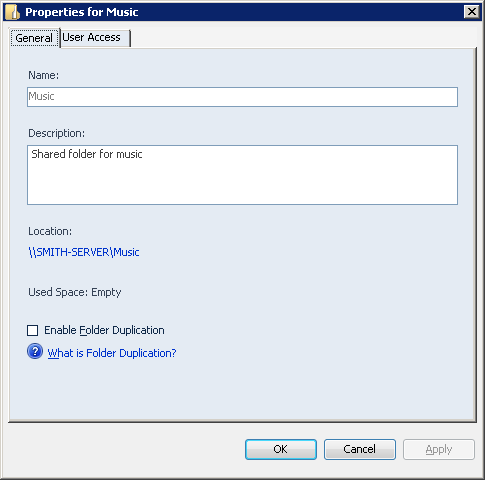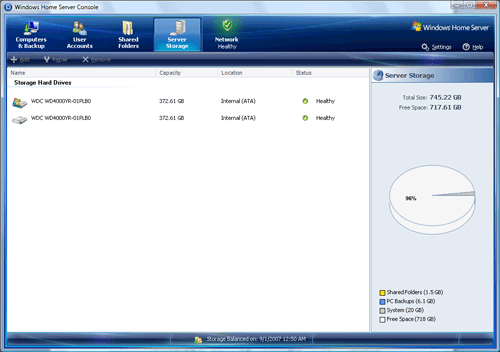A New Kind of Home Computer: Windows Home Server Preview
by Ryan Smith on September 4, 2007 1:00 PM EST- Posted in
- Systems
The Technology of WHS
Because WHS is a retooled version of Windows Server 2003, it's at times a sharp contrast to Vista, or even XP for that matter. Microsoft has attempted to put a lot of attention on WHS's headless operation mode, which allows a WHS server to run without a keyboard or monitor (but not a video card). For this purpose WHS is very much a server, as all administration tasks can be handled by the clients via a special Remote Desktop application while the server sits in a corner gathering dust. Microsoft even goes so far as discouraging use of the server directly both in the manual and on the warning dialog that pops up on the desktop of the server, in an effort to keep users inside the confines of the able but simple administrative client.

WHS also inherits Server 2003's low by modern standards system requirements, requiring as little as a 1ghz P3/Athlon processor and 512MB of RAM. Although systems shipping from computer vendors will be far more powerful, it's clear from the start that when it comes to the enthusiast market, Microsoft sees this as going on an old computer that's outlived its usefulness as a primary computer but is still well prepared for server tasks that will be limited by disk I/O and not CPU cycles or memory.
The final significant piece of technology to come over from Server 2003 is its security. By default WHS is locked down hard, bringing over the security enhancements that made Server 2003 harder to break into through a reduction in exposed services to attack. Microsoft is taking some liberties here in assuming that the server will be behind a naturally protected network with a NAT/firewall at the head. When properly configured, what is exposed to the internet (and not by default) is solely Internet Information Server 6.0, which has proven to be a hard target to break into (at least compared to the laughable IIS 5.0). Microsoft even goes so far as requiring strong passwords on any accounts that will be accessible from the internet (7 characters; uppercase, lowercase, and numeric characters required), which shows that some thought went into this.
Although Server 2003 predates Vista, the development team did manage to steal a handful of technologies from the fledgling operating system. Those tired of floppy disks will be ecstatic to find that Vista's far superior installation loader is used, allowing drivers to be loaded off of flash memory rather than floppy disks. The rest of the installer is still the traditional file-copy installer however, so WHS does not install quickly like Vista, although in Microsoft's defense users will ideally not be installing a server operating system as frequently.
Hardware and driver compatibility is something that needs to be mentioned as it's a natural result of using a server OS as the base. Simply put, a piece of hardware needs to be Server 2003 compatible to be WHS compatible. For critical components such as motherboards and video cards this shouldn't generally be a problem, although on the AMD side specifically there are some Athlon/Athlon-XP era boards that never got proper Server 2003 support. Many RAID controllers however aren't supported in spite of the availability of drivers due to WHS's unique method of handling disk drives.
Putting a new face on Server 2003 wouldn't be enough to make it capable of handling the duties of WHS in Microsoft's eyes, so among the new technologies in WHS and the one most paramount by far to its operation is what Microsoft is calling Windows Home Server Drive Extender (WHSDE). WHSDE is a new abstraction layer that sits between the various WHS services and the hardware, creating a common storage pool out of all of the available disks on the system, similar to the JBOD mode on some RAID controllers. This means that files & folders are no longer constrained by the size of any individual drive (from an end-user perspective you never even see things as drives, just folders) and instead WHSDE distributes files to drives based on how it believes space would best be allocated.
Furthermore, the storage pool is almost completely dynamic, in direct opposition to most JBOD/RAID setups. New drives can be added to the storage pool without disrupting the server, allowing the pool to be easily and continuously expanded to meet the data retention needs of the server. Drives can also be removed from the pool with a little more effort, as WHS can be informed to move all of the data off of a drive (assuming there's space elsewhere) so that the drive can be disconnected without interrupting the pool. While this isn't a completely new feature as various *nix systems have implemented similar features, this is the first we've seen it on Windows, and certainly in the running for the easiest to use implementation of such a feature.
Finally, WHSDE has a very interesting data protection feature that in many ways is a poor man's RAID 1, and yet smarter at the same time. By default WHSDE is constantly balancing all the drives so that no single drive is storing a larger percentage of data than another, so in the case of a drive failure the data lost will be an equal fraction of the data. More importantly however folders can be marked as needing additional protection (folder duplication), at which point WHSDE will make sure that the contents of that folder are on at least two separate drives when doing its balancing act. This is what makes WHSDE a poor man's RAID 1, as this balancing isn't done in real time and there's not immediately a copy of every single bit, but it's also smarter because this kind of protection is possible even among mismatched disks, disks on different controllers, external versus internal disks, etc. It offers slightly less protection than RAID 1, but as a tradeoff it's a lot more forgiving too.

At the end of the day WHSDE is really what makes WHS work and more than just a cut-down version of Server 2003. Just having a common storage pool alone makes WHS far easier to use with large amounts of data that don't fit on a single drive, and the extremely dynamic/forgiving nature of how drives and replication are handled becomes the distinguishing factor. WHSDE makes WHS far superior to any other version of Windows for storing and protecting data, and this is what gives it the ability to be a great server for home use. For enthusiasts, we suspect it will be the most attractive feature of WHS, for use as a file server.
It's also worth noting that this is the reason that WHS has very limited RAID support. Since all disks are assimilated by WHS, any RAID setups requiring configuration in Windows will fail. Only RAID setups done completely at the BIOS level (which normally requires higher-end RAID controllers) will work under WHS, and even then Microsoft discourages the use of such RAID setups in favor of the protection offered by WHS natively. RAID 5 users may want to ignore Microsoft on this however, as WHS's protection isn't as efficient as RAID 5, and it's slower due to WHS needing to balance data.











128 Comments
View All Comments
mindless1 - Wednesday, September 5, 2007 - link
Surely the backup client can be disabled (On one of the two)? I would be very surprised if 2 WHS systems can't coexist given a configuration change if you just wanted to avoid the wasted redundancy of having both make backups. That is, unless MS had deliberately chosen to prevent the two from getting along.ATWindsor - Tuesday, September 4, 2007 - link
Does it souppert proper raid, like raid 5 for instance? That fits my use a bit better than this duplication of files. WHS looks interesting, but seemingly a bit to primitive to be honest, seems to be missing quite a few more or less nescessary features.Rolphus - Tuesday, September 4, 2007 - link
The choice of OS should be entirely separate to RAID considerations. Software RAID5 is a bit of a waste of time, seeing as any performance advantage over just mirroring the data would be more than offset by software parity calculations. I don't see any reason why a BIOS-level RAID system (as supplied by many high-end and server motherboards and add-in cards) wouldn't be supported by WHS; Windows 2003 Server supports any RAID level you care to throw at it.mindless1 - Wednesday, September 5, 2007 - link
Most people won't care about parity calculation overhead, it's not as though the system is being used like a PC or workstation, that's practically ALL the system would be doing besides sitting idle, particularly given the rough spec of a 1GHz or more processor which is not at all needed just to serve files. Maybe with GbE, you might want a 300-400MHz processor to keep networking performance good but on a system that old you'd probably be bottlenecked by the PCI bus before anything else.yyrkoon - Wednesday, September 5, 2007 - link
What is wrong with software RAID, if that is all the system does(server storage) ? In my book, implementing *any* so called server OS *needs* to have at least RAID1, and should have RAID5 in software. If not, there is not realy reason to stop using WinXP Pro, with a few registry hacks tp bypass the RAID5 limitation.Anyhow, why pay for something that is lacking when you can get an OS that does it for free, or another earlier version of windows that will do it with a few hacks, and yu're already familiar with.
As I said in an earlier post, I used WHS for a few days several months ago(early beta program), and did not like what I saw. So . . .
ATWindsor - Wednesday, September 5, 2007 - link
Software raid5 can have very good performance, modern computers are fast, besides the main consideration is not wasting so much space, if you want to have som security for your files, you get by on loosing 1/4 insted of 1/2 of the space.The main advantage off WHS is the whole storage-pool-setup, I hope they implment somethin similar in w2k3.
Gholam - Sunday, September 9, 2007 - link
I tested software RAID5 on an nForce4 SLI motherboard (DFI LanParty nF4 SLI-DR) with Silicon Image 3114 chip and 4x WD 500GB drives. Reads were in 11-14MB/s range, writes sub-10MB/s, and CPU load was near full, on an Athlon 64 4000+.ATWindsor - Sunday, September 9, 2007 - link
Try to test a proper software-raid, instead of the inbuilt nforce-crap, just because you tested a poor solution doesn't make all solutions bad.Gholam - Sunday, September 9, 2007 - link
It's not nForce, it's SiI3114, nearly ubiquitous on higher-end motherboards of that era, as well as present on many lower-end PCI cards. Building RAID5 on an "affordable" solution from Silicon Image, Promise and such will give you exactly that kind of performance, as well as guarantee a high probability of data loss due to driver/firmware bug. In order to run RAID5 you need a proper controller from Adaptec/LSI Logic/3Ware, and that costs big bucks.Ryan Smith - Tuesday, September 4, 2007 - link
It only supports proper RAID if you can configure it all in the BIOS. Any kind of softRAID that needs Windows' help isn't supported. Basically it needs to appear as 1 disk to Windows.